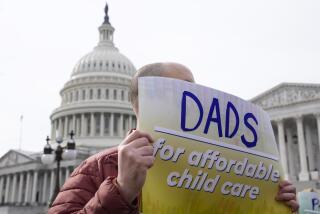Think You’ve Had a Harder Time of It Lately? Well, You Have
- Share via
If you feel squeezed for money and time and are perhaps worried about finding decent child care, you are not alone.
The Census Bureau’s flood of data and an authoritative private survey confirm that families are increasingly finding it a struggle to balance the demands of work and home at a time when their paychecks are barely growing.
Consider this: The cumulative loss of income since 1973 is $160,000 for a family of four, because the U.S. economy hasn’t performed up to its robust historical standard, according to some economists. The economy’s growth rate, which had averaged 3.4% a year since the Civil War, has slowed to a scant annual average of 2% over the past 23 years, says economist Daniel A. Pavsek of Shenandoah University.
The options available to maintain a family’s standard of living when its paychecks aren’t growing fast enough are: Send more members of the household into the work force, work overtime or pile up debt. Americans have been doing all of these things.
The percentage of women in the work force has soared from 39% in 1965 to 59% this year, the government says, and the trend shows no sign of slowing down.
Women who work full time contribute about 40% of family earnings, 30% if they work part time, according to experts at the Bureau of Labor Statistics.
The money from a second worker makes a big difference in relative prosperity. According to 1994 figures, the median family income for two-earner couples was $54,906 (“median” means that half the families earned more, half earned less.) If the husband was the sole breadwinner, median income was $35,240. For the millions of households headed by women, median income was much lower, $23,700.
For all families, whether headed by a couple or single parent, leisure time is in short supply.
The average worker spends more than 40 hours a week on the job, and overtime and commuting add five hours more a week, according to a recent national study by the Families and Work Institute, a New York-based research group funded by foundations and corporations.
“In attempting to juggle work and family life, personal time is often sacrificed,” said the report. Researchers used a national sample for the most comprehensive private study ever of work and the family. The group of more than 3,400 workers was statistically balanced so as to reflect the full labor force of 130 million.
Further evidence of stress on the work force comes from the government’s periodic employment reports, which show overtime for factory workers running at the highest level in decades.
Many families feel they have no choice when it comes to taking on more work. According to the Families and Work Institute survey, about 54% of married women with children under 6 “felt it would be quite difficult or extremely difficult for their families if they didn’t have a paid job.”
The more educated women are, the more money they make, and the more likely they are to hurry back to work after a baby is born.
According to the Census Bureau, most women--53%--who had had a baby in the previous 12 months were in the work force in 1994. The differences by education and income was striking. Among mothers of newborns, 70% of the women with a college or advanced degree were working, compared with 48% for women with a high school diploma and 34% for those who did not finish high school.
Money, or rather the fear of losing it, motivates them to return to work, according to the Census Bureau. The “highly educated women with prior career commitments and higher earning potential would suffer greater losses from work force interruptions, such as having a child,” the bureau reports in its “Population Profile of the United States.”
The potential sacrifice of income would encourage “a more rapid reentry into the labor force after a child’s birth,” the report says.
Juggling the demands of children, families and jobs makes child care a vital, and frustrating, topic for many Americans. “It is certainly a major problem for working couples today,” said Howard Hayghe, an economist with the Bureau of Labor Statistics.
In response to the demand, organized day-care centers are part of a fast-growing industry, caring for 30% of children in such care in 1993, the highest percentage ever recorded. The climb from 23% in 1991 was “quite an impressive increase,” said Lynne M. Casper, a Census Bureau statistician.
Fathers provided 16% of the day care in 1993, down from 20% in 1991, a recession year, she said. “More dads then were unemployed or working part time” and were available for day care, Casper said.
“Any time you have a squeeze on your pocketbook, spending patterns change and you try to pull in your belt as best you can,” she noted. When the economy gets worse again, more fathers will be handling day care.
More to Read
Inside the business of entertainment
The Wide Shot brings you news, analysis and insights on everything from streaming wars to production — and what it all means for the future.
You may occasionally receive promotional content from the Los Angeles Times.










